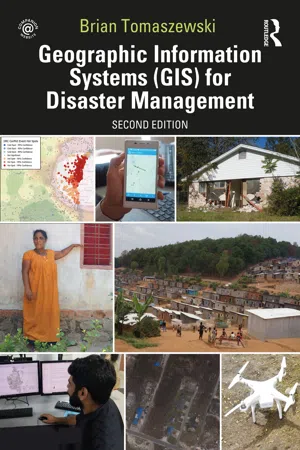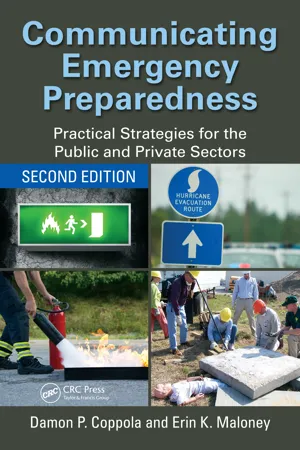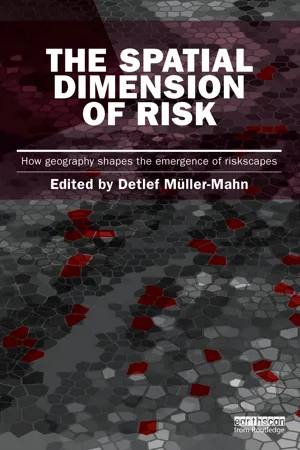Hazard Management Cycle
The Hazard Management Cycle is a framework used to guide the management of natural and human-made hazards. It consists of four main phases: mitigation, preparedness, response, and recovery. These phases help to organize and prioritize actions to reduce the impacts of hazards on communities and the environment.
5 Key excerpts on "Hazard Management Cycle"
- Brian Tomaszewski(Author)
- 2020(Publication Date)
- Routledge(Publisher)
...Research on disasters or the realization of a catastrophic event has tended to be in the domain of psychology, sociology, and, more recently, information technology (ISCRAM 2019). As we have seen so far in this book, disaster research within geography has focused on the role of GIS and related technologies in the response phase (Kevany 2003) However, GIS is relevant to all aspects of disaster management. Disaster management is interpreted here as resource organization and management of activities related to the disaster cycle or preparing for, responding to, recovery from, and mitigating against disasters (International Federation of Red Cross and Red Crescent Societies 2019; Federal Emergency Management Agency [FEMA] 2019). Although variations exist on the specific disaster-cycle category descriptions, these four are the most commonly used and relevant to the discussion in this book. Figure 5.1 visually demonstrates the idea of the disaster cycle and how GIS underlies each disaster-cycle phase. Figure 5.1 The disaster management cycle. GIS can play active roles in and across each disaster-cycle phase. For example, starting with preparedness, or actions taken prior to a disaster with the intent of ensuring a better event response, GIS can be incorporated into technological training such as showing a first responder how to use mobile GIS technologies such as global positioning system (GPS)-based smartphone mapping applications or providing citizens with maps of emergency shelters and evacuation routes. Preparedness can also include planning activities such as building GIS hardware, software, datasets, and training capacity for when an event does occur so that GIS is ready for operational and decision support...
- eBook - ePub
Climate Change and Natural Disasters
Transforming Economies and Policies for a Sustainable Future
- Vinod Thomas(Author)
- 2017(Publication Date)
- Routledge(Publisher)
...Disaster management cycles can be divided into equally important phases: pre-disaster, disaster relief, and reconstruction and recovery (figure 5.1). Much more must be done to prepare for disasters, before disaster strikes, rather than reacting only after the fact. Although the precise location, timing, or intensity of a hazard is unpredictable, disasters tend to concentrate and recur in certain regions or countries. For this reason, a variety of measures can be taken before a disaster strikes. No one country typifies good practices, but there are examples to build on. Capacity to respond is extremely vital, as shown by the experiences of Malaysia and Singapore in search and rescue. Thailand, in the wake of the 2011 floods, promoted catastrophe insurance for small businesses. Bangladesh’s cyclone warning system is another good example. After Cyclone Bhola, with wind speeds of two hundred kilometers per hour, killed over five hundred thousand people in 1970, Bangladesh invested $10 billion on cyclone readiness. With the country equipped with early warning systems, disaster-resilient shelters, and embankment protection, Cyclone Sidr in 2007, with wind speeds of 250 kilometers per hour, led to a much lower death toll at ten thousand (Thorlund and Potutan 2015). Figure 5.1 Disaster management cycle. Source : Author’s illustration adapted from Strauss (n.d.) and Todd and Todd (2011). It is important to mobilize funds, secure investments for DRR, and build capacities across institutions for disaster monitoring and response before disaster strikes. When it does strike, mobilizing the necessary proactive and immediate response then requires building on institutional and financial capacities from the earlier stage (Todd and Todd 2011). Actions in each phase have implications for the management and effectiveness of the subsequent phase, and each deserves equal attention...
- eBook - ePub
Communicating Emergency Preparedness
Practical Strategies for the Public and Private Sectors, Second Edition
- Damon P. Coppola, Erin K. Maloney(Authors)
- 2017(Publication Date)
- Routledge(Publisher)
...Each of these functions is described in the following sections. Mitigation Mitigation involves the reduction or elimination of one or both of a hazard’s risk components (likelihood and consequence). Sometimes called the “cornerstone of disaster management” (FEMA 2005), mitigation seeks to “treat” hazards such that they affect society to a lesser degree. While the three other components of the disaster management cycle (preparedness, response, and recovery) are performed either as a reaction to hazards or in anticipation of their consequences, mitigation measures seek to reduce the likelihood or consequences of hazard risk before a disaster ever occurs. Of course, mitigation is by no means the simple answer to a hazard problem. In fact, because of the difficulties often associated with most mitigation measures, it is only in the last few decades that their full risk reduction potential has been recognized. In practice, mitigation measures tend to be costly, disruptive, time consuming, and socially unpalatable. They usually carry their own inherent risk and do not always work as intended. Political will for mitigation is hard to come by in many situations, and the public’s attention span tends to be too short to accommodate the significant life changes that may be necessary for mitigation to work. However, as the practice of mitigation grows, it will continue to emerge as a means of measurably reducing the incidence of many types of disasters. Preparedness Preparedness involves equipping people who may be affected by a disaster, or who may be able to help those affected, with the tools to increase their likelihood of survival and to minimize financial and other losses. This is achieved by training and equipping response agencies at each government level, and by educating the public about what actions they can take to reduce their individual vulnerability and risk...
- eBook - ePub
The Spatial Dimension of Risk
How Geography Shapes the Emergence of Riskscapes
- Detlef Muller-Mahn, Detlef Muller-Mahn(Authors)
- 2012(Publication Date)
- Routledge(Publisher)
...By the normatively formalised act of delineating hazard zones, a spatial distinction is made between those areas that are – per legal definition – at risk and areas that are safe and therefore suitable for development activities. As a result, a difference is recognised between the acts of accumulating geographical facts and representing the spatial form embedded in these facts; and understanding the processes involved in analysing these facts (Golledge 2002): by intersecting the defined hazardous areas with values at risk, new information (on risk) is produced that is not directly a result of data gathering. From an institutional point of view, the concept of risk, even if referred to as a construct of ideas with multiple facets, is the most suitable tool for defining such spatial characteristics, and drawing boundaries in the landscape that separate areas differently affected by hazards and, consequently, societal threats (Keiler and Fuchs 2010). As a result, spatially relevant theories about the location, arrangement and distribution of geographical phenomena and spatial interaction between both physical and human components of those phenomena are developed in order to understand human–environment interaction. 2 Time in the Institutional Dimension of Natural Hazard Risk Management The fundamental impetus for any form of risk management is an awareness of the threat, a notion of responsibility (which in the case of mountain hazards in Europe is regularly taken over by the political regulator instead of being borne by the individual, Fuchs 2009) and a belief that human action might reduce the risk (Crozier 2005). In the broadest sense, risk management options are developed to identify and assess risk, to prioritise appropriate mitigation activity for the reduction of risks found to be situated above a level of societal tolerability, and to lessen the effects of the underlying hazardous events...
- eBook - ePub
- Steve Mustard(Author)
- 2018(Publication Date)
- International Society of Automation(Publisher)
...Risks are identified and then assessed to determine their severity to the organization. As a result of the assessment, controls are identified to manage these risks. In order to effectively manage risk, the risks and the associated controls must be reviewed on a regular basis to determine: • If any risk has occurred • If each risk is still present • If the severity of each risk has changed • If the controls are in place • If the controls are effective Based on this review, controls may be changed or added. The cycle (see Figure 7-1) continues as new risks are identified and managed. Figure 7-1. The Risk Management Cycle Risk Management Components Table 7-2 lists the key components of risk management plans. Table 7-2. Key Components of Risk Management Plans Risk Risk is the potential for something bad to occur. Risk is the combination of two factors: the likelihood that an event will occur and the consequence of that event occurring. Risk is often described in terms of an equation, Risk = Likelihood • Consequence. Likelihood Likelihood is the estimate or probability that an event will occur. This may be written as a probability (1 in 100), a percentage (10%), or in some other meaningful way (e.g., “once in 10 years”). Consequence Consequence is the expected impact of an event occurring. This may be expressed as a financial value, an impact on workers (e.g., number injured or killed), or in some other way that is meaningful to the organization concerned. Hazard A hazard is a source of potential damage or harm. Hazards can be natural (e.g., a hurricane or flood) or man-made (e.g., an exposed electrical circuit). Threat A threat is another name for a hazard, but it is particularly common in the management of cybersecurity risk. Threats can be accidental (a user making a mistake) or deliberate, and can be caused by insiders (employees) or outsiders (hackers)...




